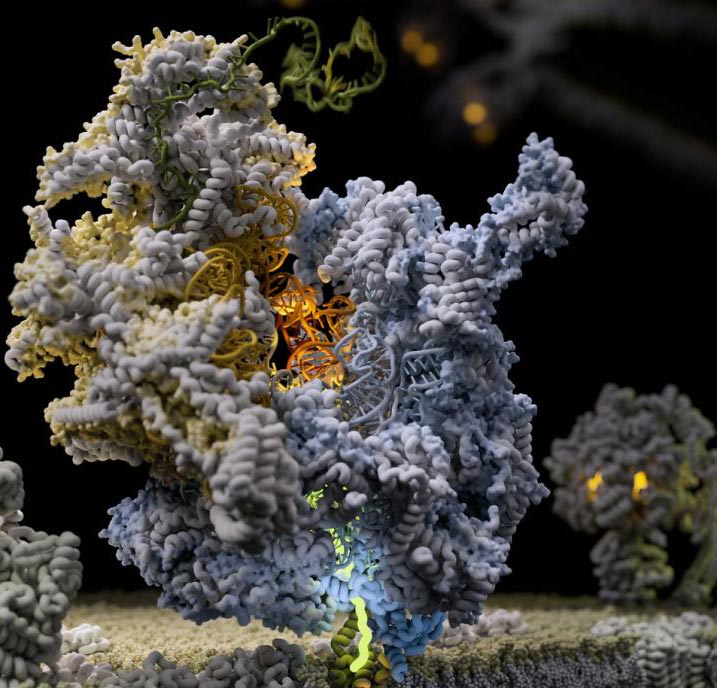Advanced imaging technology captures translation of the maternal genome

Advanced imaging technology captures translation of the maternal genome.
Credit: A. Amunts and D. Nowakowski
An international collaboration among researchers from Finland, Sweden, UK and the USA has captured ribosomes translating messenger RNA expressed from the maternally inherited mitochondrial genome. Utilising the latest advances in cryo-electron microscopy, the group discovered a novel mechanism that mitochondrial ribosomes use for the synthesis and delivery of newly made proteins to prevent premature misfolding. Disruptions to protein folding can lead to devastating human diseases.
There is a familiar saying, “It’s all in the genes”. As modern archaeology reveals, the DNA that encodes genes can be found among the remnants of our ancestors and from any organism, small and large, that once roamed the earth. The genetic blueprint alone is not sufficient; life requires the faithful expression and translation of our genomes. Basic research in molecular biology has revealed in beautiful detail the mechanisms by which these fundamental processes operate. One of these pioneering discoveries was that of Nobel Prize winners François Jacob and Jacques Monod, who established the paradigm that we now know as cellular gene expression, whereby the information in our genome is transcribed, read and converted into functional proteins. Since then, researchers young and old have been filling in the details of these incredible processes to uncover the complexity of biology.
In a recent study published in Science an international collaboration of researchers, involving University of Helsinki researchers Dr. Brendan Battersby and Dr. Uwe Richter, built upon this tradition by revealing the specialized mechanism for translation of the mitochondrial genome into proteins.
Within the cells that make up the tissues and organs of our bodies, mitochondria compartmentalise the breakdown of nutrients with oxygen into the conversion of cellular energy. As a result, it is best known as the powerhouse of the cell. This function is dependent upon the faithful expression of the maternally inherited mitochondrial genome. Disruptions to the process underlie a large group of human diseases that can strike at any age, differing in the affected tissue and severity. Despite the importance, the molecular mechanisms of these processes have remained obscure. However, the breakthrough in biological imaging brought about by cryo-electron microscopy now provides researchers with the tools to investigate the functions of individual proteins at unprecedented resolution and detail.
By combining forces with Dr. Alexey Amunts at Stockholm University and Karolinska Institutet and Professor Antoni Barrientos at the University of Miami Miller School of Medicine, the group used their collective know-how to capture the mitochondrial ribosome translating messenger RNA (mRNA) into a protein. The structure revealed a unique gating mechanism to prevent newly made proteins from prematurely misfolding. For proteins to be functional within our cells requires coordinated folding processes to obtain a correct 3D shape. Disruptions to protein folding can have profound biological implications for all organisms and in humans lead to devastating diseases.
“Getting a direct picture of a biological process that we investigated for several years by biochemical and genetic tools is absolutely electrifying!” says Uwe Richter, a shared first author and Principal Investigator at the University of Helsinki and Newcastle University.
“This study highlights the power and brilliance of international collaborative basic science driven from the bottom-up,” says Research Director Brendan Battersby, who is one of the corresponding authors. “There is a worrying trend among scientific funding agencies to direct research from the top towards goal-oriented tasks pursued by large consortia, and in the process deprive research funds away from individual investigators who are the cornerstone of scientific discovery. The best scientists will always seek each other out to follow the creativity of their ideas, which the track record shows unquestionably leads to real innovation in the end.”
“Understanding the fine details of these cellular mechanisms has important considerations for human diseases but also for the side-effects of commonly prescribed antibiotics. Mitochondrial gene expression has many overlaps with that of bacteria and as a result many antibiotics used to treat bacterial infections can also disrupt our cellular powerhouses, accounting for side-effects of these medications. Solving these ribosome structures is integral to the development of effective and safe new antibiotics in the future. In the end, this highlights the importance of basic bottom-up research and how it continues to drive innovation and we cannot afford to lose it,” highlights Dr. Battersby.
All latest news from the category: Life Sciences and Chemistry
Articles and reports from the Life Sciences and chemistry area deal with applied and basic research into modern biology, chemistry and human medicine.
Valuable information can be found on a range of life sciences fields including bacteriology, biochemistry, bionics, bioinformatics, biophysics, biotechnology, genetics, geobotany, human biology, marine biology, microbiology, molecular biology, cellular biology, zoology, bioinorganic chemistry, microchemistry and environmental chemistry.
Newest articles

Eruption of mega-magnetic star lights up nearby galaxy
Thanks to ESA satellites, an international team including UNIGE researchers has detected a giant eruption coming from a magnetar, an extremely magnetic neutron star. While ESA’s satellite INTEGRAL was observing…

Solving the riddle of the sphingolipids in coronary artery disease
Weill Cornell Medicine investigators have uncovered a way to unleash in blood vessels the protective effects of a type of fat-related molecule known as a sphingolipid, suggesting a promising new…

Rocks with the oldest evidence yet of Earth’s magnetic field
The 3.7 billion-year-old rocks may extend the magnetic field’s age by 200 million years. Geologists at MIT and Oxford University have uncovered ancient rocks in Greenland that bear the oldest…





















